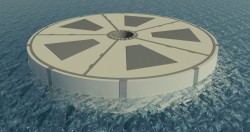Wave energy has the potential to contribute to the UK’s race to reach net zero carbon by 2050 with precast concrete a major factor in making this happen. Karoline Lende, Engineer, Advanced Digital Engineering for Arup explains more.
The current cost of wave energy converters (WECs) means large scale deployment is not yet commercially viable. Funded by Wave Energy Scotland (WES), a team of structural engineers from Arup has been looking at ways in which concrete can help reduce the cost of WECs, and ultimately ensure that the wider wave energy sector can adopt these innovations.
The Arup team has been seeking to unlock the opportunities for innovative concrete construction techniques to drive down the cost of WECs, which are typically constructed from steel. Following a sector-wide review of WEC types, floating devices were found to have the most potential for innovation and cost reduction. For these devices, structural concrete offers a more efficient solution by using the weight of the structure directly, rather than requiring additional ballast.
After a series of research, design, modelling and physical testing stages, Arup’s specialist material and structural experts concluded that the use of concrete for WECs could reduce the through-life cost of floating wave energy devices by up to 20%. Whilst concrete is a widely used and well understood material in the built environment, its use in lightweight floating structures is less well established. To demonstrate the technical feasibility of using concrete for floating WECs, Arup developed two concrete designs to Front End Engineering Design level, working closely with contractor BAM to develop innovative manufacturing solutions and drive down cost. This included designing a load-bearing precast concrete connection detail, which underwent full-scale physical testing to demonstrate watertightness. The interleaved T-headed bar connection detail achieves full load transfer at the joint whilst using hydrophilic strips to prevent water ingress.
Arup also explored the wider benefits from using concrete beyond cost reduction. The material can take advantage of a mature supply chain and increased local construction content. Concrete has superior durability compared to steel in the offshore environment and can typically offer a 50-year design life, further reducing through-life cost. Arup also assessed the embodied carbon of different designs, concluding that concrete devices would be more favourable than steel devices in terms of environmental impact and global warming potential.
To enable WEC developers to understand and realise the potential for concrete, Arup has placed great emphasis on disseminating the findings of the project. They have created a digital decision-making tool – Convex – helping WEC developers exploit the knowledge gained throughout the project by assessing the feasibility of incorporating concrete in their designs.
The Arup team have demonstrated the commercial opportunity associated with concrete WECs. With further work by WEC developers and the concrete supply chain to maximise the chance of successful exploitation, wave energy could play an important role in the UK’s renewable energy mix. Arup are continuing to work with developers in this innovative sector and has transferred the findings of the study to floating offshore wind substructures where concrete could also have a significant impact.
To read full article and for more news, check out the latest Offsite Magazine









